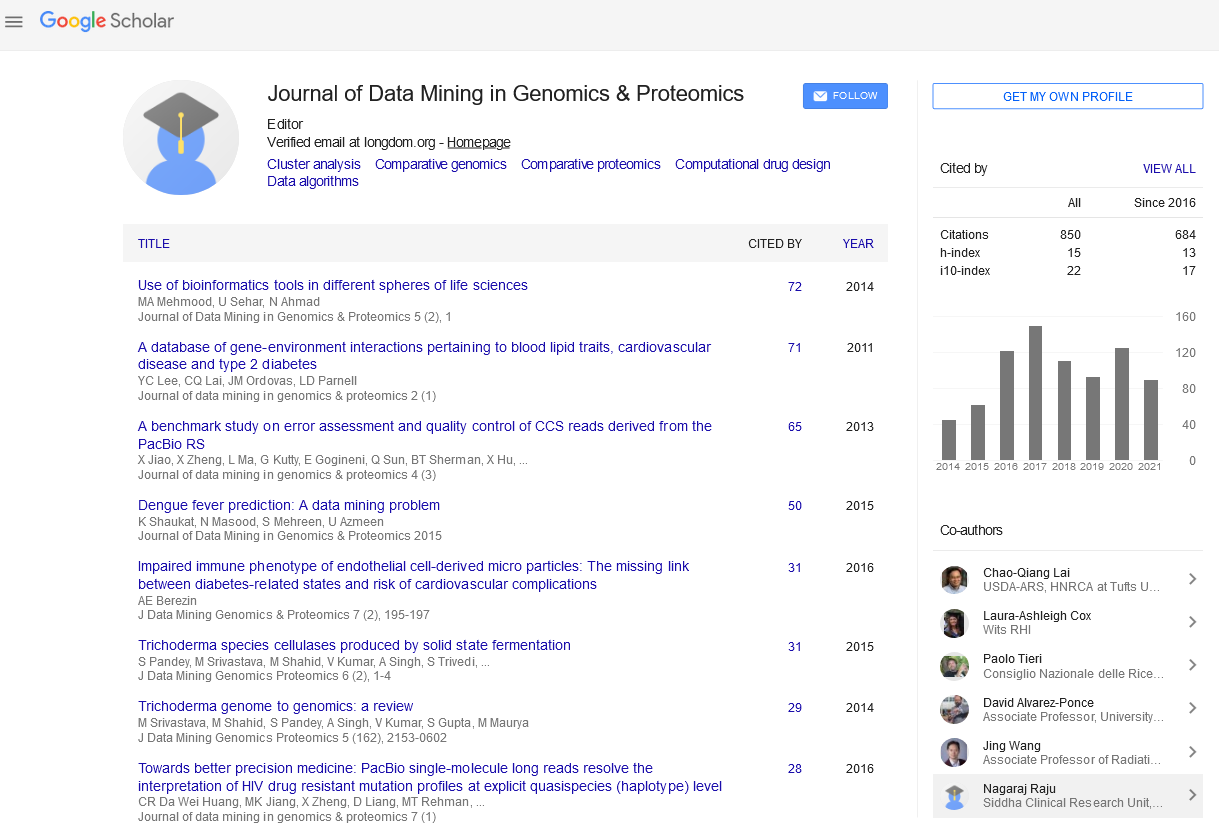PMC/PubMed Indexed Articles
Indexed In
- Academic Journals Database
- Open J Gate
- Genamics JournalSeek
- JournalTOCs
- ResearchBible
- Ulrich's Periodicals Directory
- Electronic Journals Library
- RefSeek
- Hamdard University
- EBSCO A-Z
- OCLC- WorldCat
- Scholarsteer
- SWB online catalog
- Virtual Library of Biology (vifabio)
- Publons
- MIAR
- Geneva Foundation for Medical Education and Research
- Euro Pub
- Google Scholar
Useful Links
Share This Page
Journal Flyer

Open Access Journals
- Agri and Aquaculture
- Biochemistry
- Bioinformatics & Systems Biology
- Business & Management
- Chemistry
- Clinical Sciences
- Engineering
- Food & Nutrition
- General Science
- Genetics & Molecular Biology
- Immunology & Microbiology
- Medical Sciences
- Neuroscience & Psychology
- Nursing & Health Care
- Pharmaceutical Sciences
Proteomic analysis of oral carcinogenesis by using gel-based and gel-free quantitative approaches
2nd International Conference on Big Data Analysis and Data Mining
November 30-December 01, 2015 San Antonio, USA
Zhi Wang, Kai Su, Sijia Zhao, Da Ma, Xiaobing Chen and Peixi Liao
Sun Yat-sen University, China
Posters-Accepted Abstracts: J Data Mining Genomics Proteomics
Abstract:
In this study, both gel-based two-dimensional fluorescent differential gel electrophoresis (2D-DIGE) and non-gel-based isobaric tags for relative and absolute quantitation (iTRAQ) coupled with liquid chromatography-tandem mass spectrometry have been used as screening tool for identification of differentially expressed proteins as potential biomarkers for oral malignant transformation. We comparatively analyzed the proteome profiles of multi-step tissues from normal epithelial tissues to premalignant oral leukoplakia (OLK) tissue and infiltrative oral squamous carcinoma(OSCC) tissues identically from three patients. In all, 1,465 unique proteins were identified. Of those, 240 were potentially differentially expressed between OSCC and normal tissues while 111 between normal and premalignant tissues, 202 between premalignant tissues and OSCC tissue. Subcellular location and functional annotation was done by Gene Ontology (GO). Pathway data was derived from KEGG and Biocater. Also of interest, we compared the different proteomic profiles between DIGE and iTRAQ. In general, nearly all the protein categories of DIGE was included in iTRAQ, but with different protein family members. The most significance is Annexin family, S100 calcium binding protein family, Heat shock protein family and keratins. Calcium regulation related proteins were validated by Western blotting and RT-PCR. Furthermore, up-regulation of those proteins was validated in OSCC tissue microarrays by immunohistochemistry. The correlation with malignant transformation as well as recurrence and disease-free survival of patients with OSCC also was estimated. Our study represents the successful complementary application with DIGE and iTRAQ to an investigation of oral malignant transformation, also provide valuable novel insights into the underlying mechanisms of oral carcinogenesis.
Biography :
Zhi Wang has completed her Ph.D. and D.D.S at the age of 29 years from West China Stomatological College, Sichuan University. Now, she is a professor and vice director of Department of Oral medicine, Guanghua school stomatology, Hospital of stomatology, Sun Yat-sen university. She has been devoting herself to pursue more effective methods for early diagnosis, prognosis analysis and more effective treatment in head and neck cancer. In the recent five years, she has published more than 25 papers in reputed journals and has been cited more than 158 times.


